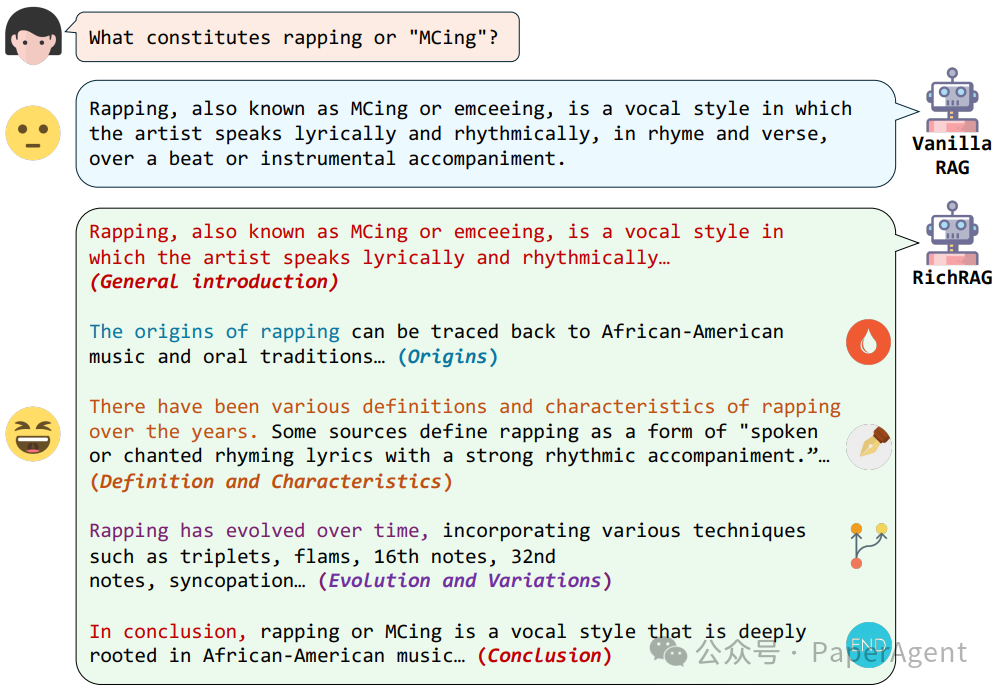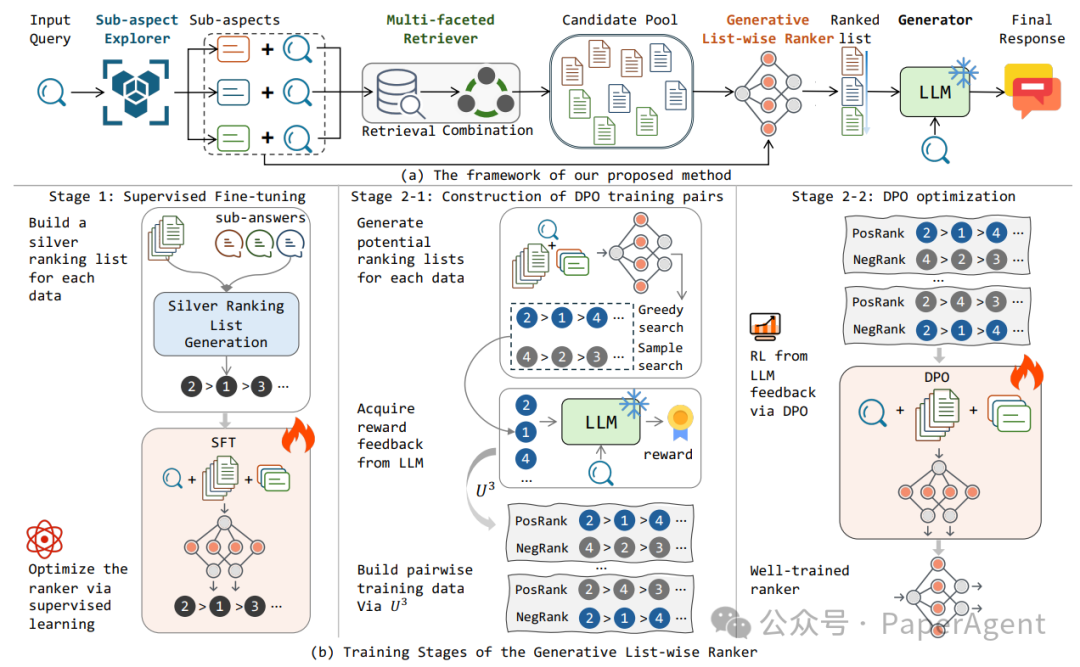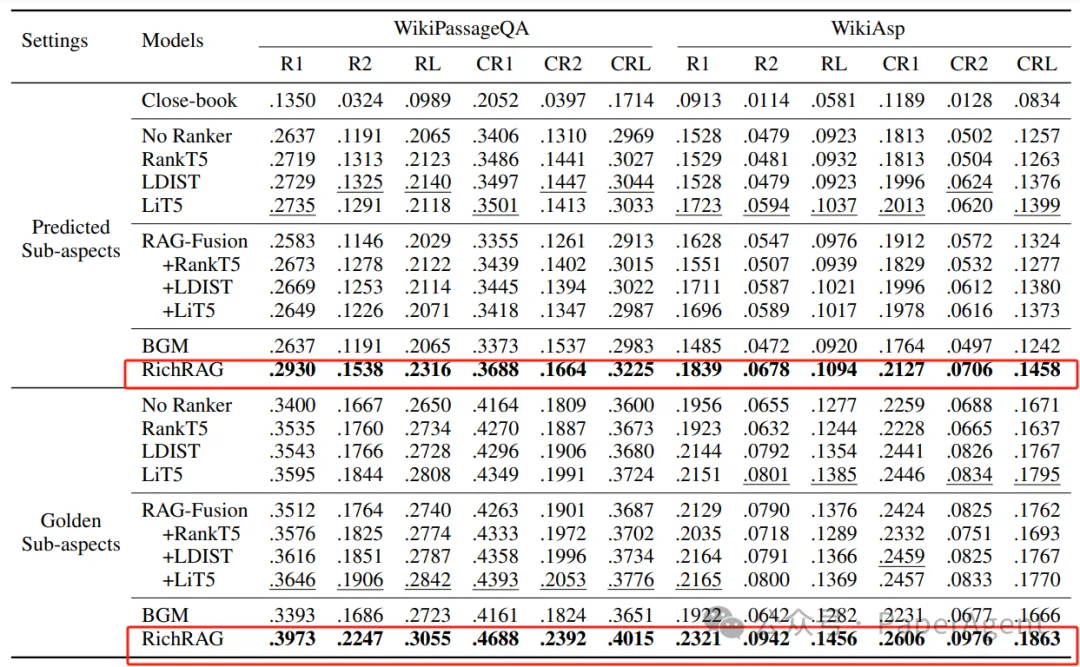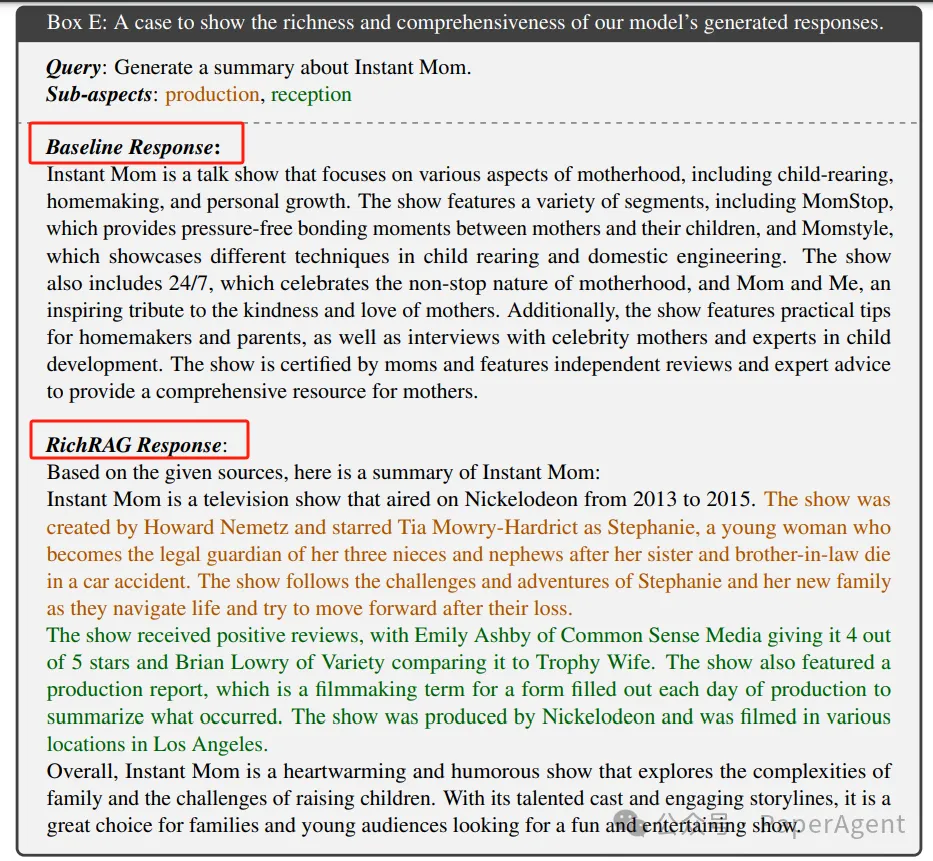RichRAG框架:為用戶提供豐富全面且令人滿意的回答
檢索增強型生成(RAG)使LLMs能夠利用檢索到的可靠信息,從而返回更可靠的響應。現有研究主要關注需要簡潔明確答案的特定問題,但用戶意圖通常是復雜和多方面的,需要豐富和全面的答案。
一個多方面查詢需要全面回答的情境示例

為了解決這一重要但未被充分探索的問題,提出了一種名為RichRAG的新型RAG框架:
子方面探索器:識別輸入問題潛在的子方面。
多方面檢索器:構建與這些子方面相關的多樣化外部文檔候選池。
生成式列表智能排序器:關鍵模塊,為最終生成器提供最有價值的文檔排名列表。
RichRAG的整體框架。在底部描述了排名器的訓練階段

1 問題定義
在基本的RAG設置中,包含知識庫C、固定檢索器R和作為生成器的固定LLM G。對于多方面的問題q,其下屬的各個方面表示為S={s1, ..., sn},這些子方面有相應的子回答A={a1, ..., an}。目標是使RichRAG生成的回答r不僅與真實回答匹配,而且全面覆蓋各個子回答,確保回答的豐富性和完整性。
2 子方面探索器
利用LLM構建子方面探索器E,預測輸入查詢的子方面。該模塊輸入提示pse和用戶查詢q,生成一系列子方面。
3 多方面檢索器
根據查詢的子方面,使用多方面檢索器收集與各種子方面相關的文檔,構建多樣化的候選文檔池。這包括針對每個子方面檢索文檔的過程和合并檢索到的文檔以創建候選池。
4 生成式列表智能排序器
為了從候選池中篩選出最有價值的文檔,設計了一個基于生成模型的排名模型。該模型輸入用戶查詢、識別的子方面和所有候選項,直接生成頂級文檔ID的排名列表。排名器采用兩階段優化:監督式微調和強化學習。
4.1 監督式微調
使用貪婪算法構建銀牌目標排名列表,支持排名器的監督式微調。通過覆蓋效用函數,測量每個剩余文檔的增量方面覆蓋增益。
4.2 強化學習
使用強化學習策略探索更好的排名可能性,以最終回答的質量作為排名列表的獎勵,采用直接偏好優化(DPO)算法優化排名器,并引入單邊重要性采樣策略(US3)構建有價值的訓練樣本。
在兩個公開可用的數據集上進行的實驗結果證明,RichRAG框架能夠有效地為用戶提供全面且令人滿意的回答。
所有模型的總體結果。最佳和次佳結果分別用粗體和下劃線標出

不同子方面數量的子集實驗,RichRAG框架在所有子集上都優于所有基線,框架在多樣化搜索場景中的魯棒性

Prompt模板:標注問題方面,并將長答案拆分成相應的子答案
Your task is to adjust the results of query-facets mining. The query-facets are extensions of the
original query in various generic perspectives, rather than some specific facts. Given a query that
requires information from multiple query-facets, you should return all query-facets of the query
to fully answer it query. Note that each query has at least two query-facets. I will give you the
long-form answer to the original query to help you explore query-facets based on the perspectives
of its answer. But refrain from using the additional information from the answer to generate the
query-facets. Then you should segment the original long-form answer into several sub-answers
that each are paired with a query-facet. Please return each query-facet of the original query and its
corresponding sub-answers. The query-facets and sub-answers should be one-to-one and returned
in JSON format. You need to follow the following rules:
1. The answers are only used to help you determine the generic direction. You mustn’t generate
query-facets based on the contents of answers and the facets mustn’t contain the answers’
additional information beyond the input query.
2. Sub-answers are constructed by segmenting the original answer, you cannot generate or reorder
the original answer to create sub-answers.
3. The sub-answers should be complete. You must ensure that when the sub-answers are joined
together in order, the complete original answer should be formed.
4. The generated query-facets should be sufficiently generic and contain no specific information
about the sub-answers.
5. **You should ensure that generated query-facets cover all perspectives original answer.**
6. **You should ensure that all sub-answers cover all contents of the original answer.**
7. **The number of query surfaces must range from 2 to 7.**
8. **You should ensure that each query-facet is sufficiently generic and can be easily derived from
the original query.**
9. **You should ensure each query-facet contains no information from the answer.**
10. **You should rewrite or combine the query-facets to be more generic if some query-facets do
not meet the above requirements.**
11. The returned results should be in JSON format and contain the following key: results, which
is a list of JSON data. Each item of results should contain the following keys: query-facet, and
sub-answer.
12. I will give you some demonstrations, you should learn the pattern of them to mine query-facets
and split sub-answers.
**Demonstration**
{demonstrations}
Query: {query}
Answer: {answer}
Results:
對于RAG整個框架的更多技術,PaperAgent團隊RAG專欄進行過詳細的歸納總結:高級RAG之36技(術)。
高級RAG之36技試看私信獲取:RAG專欄
RichRAG: Crafting Rich Responses for Multi-faceted Queries in Retrieval-Augmented Generation
https://arxiv.org/pdf/2406.12566
本文轉載自??PaperAgent??

















